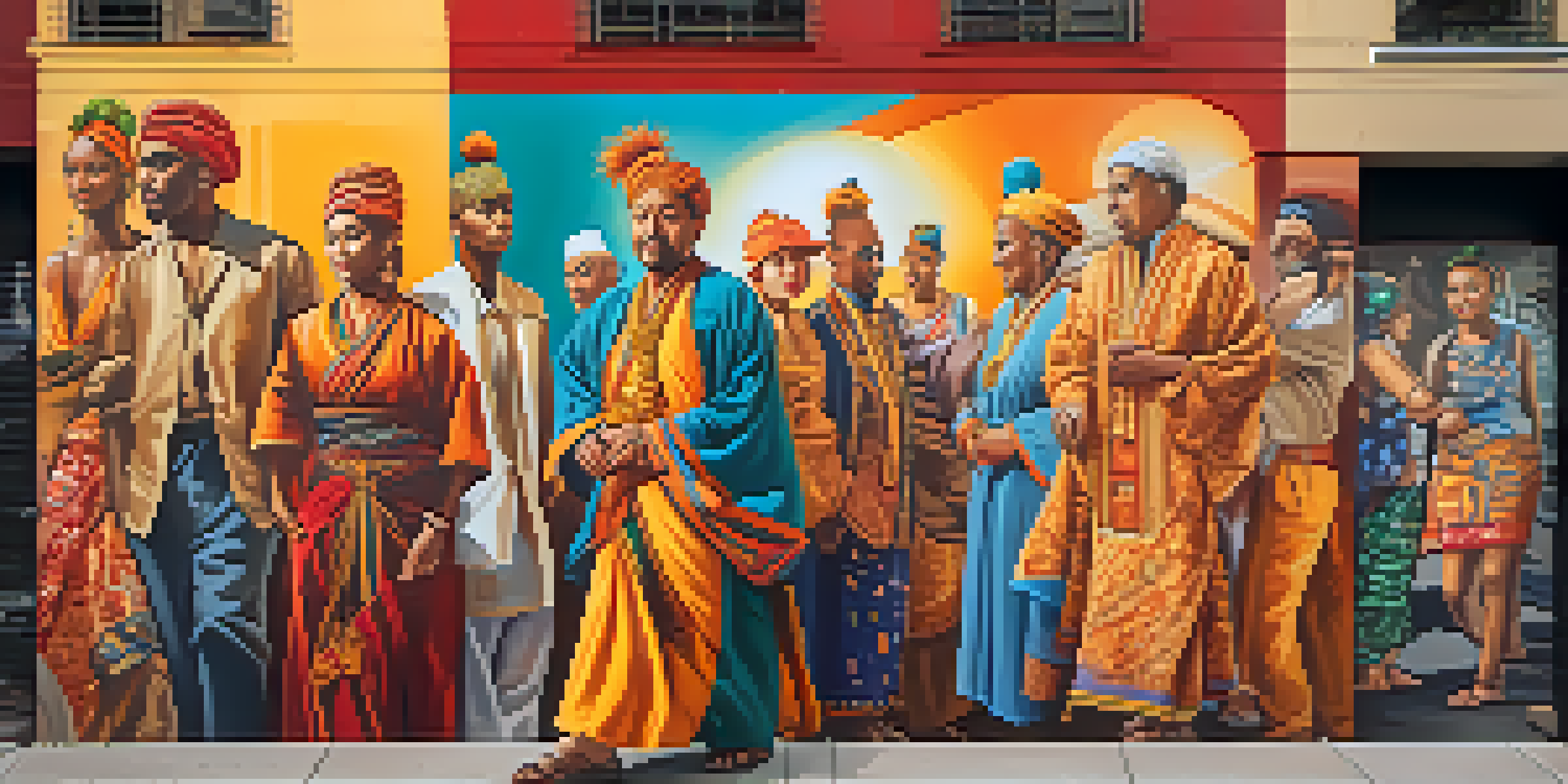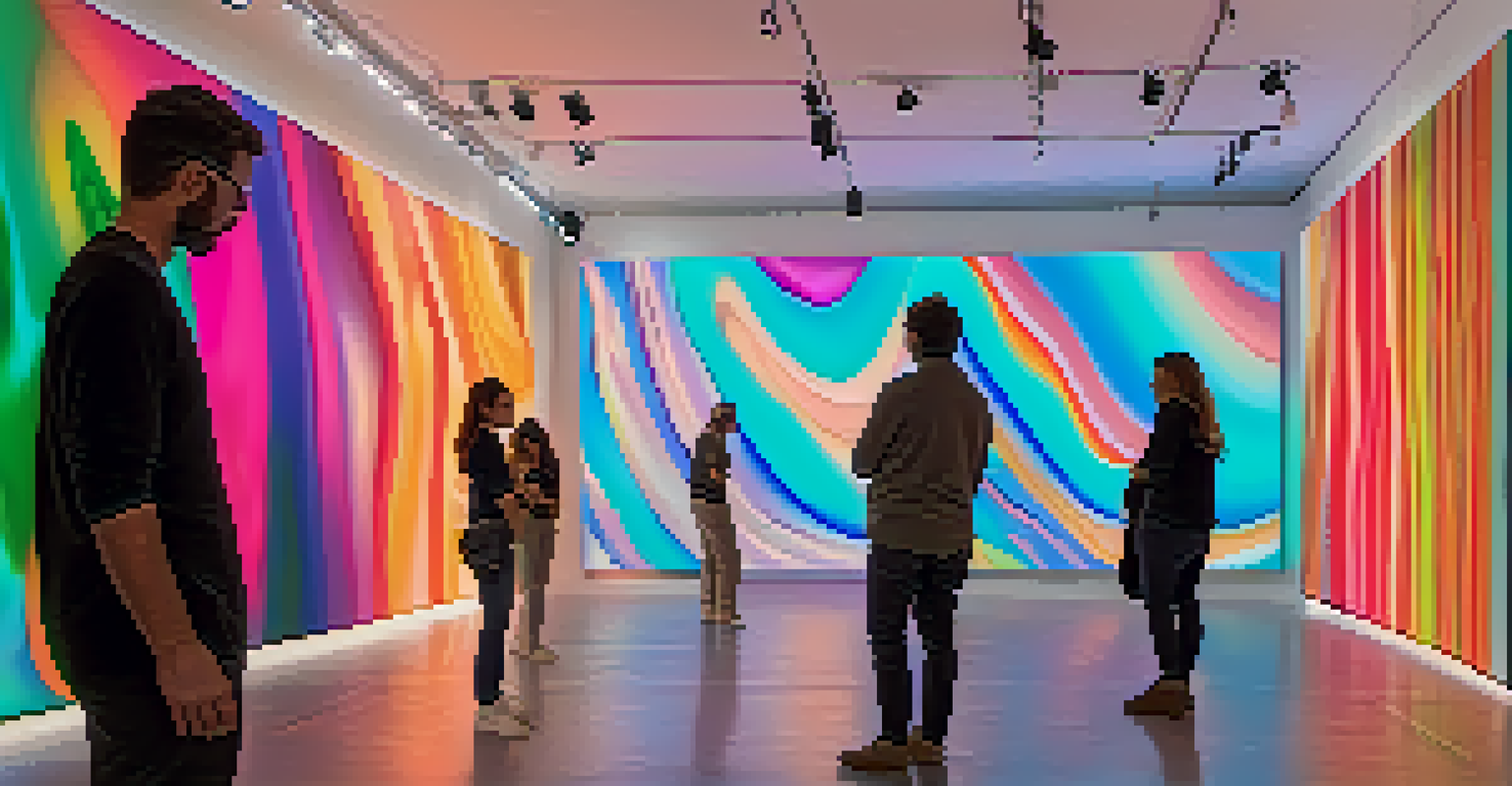Art and the Exploration of Identity in a Globalized World

The Role of Art in Shaping Personal Identity
Art serves as a powerful medium for individuals to express their unique identities. Through painting, music, and performance, people can convey their personal stories and cultural backgrounds. This personal expression can resonate deeply, allowing others to connect with shared experiences or emotions.
Art enables us to find ourselves and lose ourselves at the same time.
For instance, an artist may draw inspiration from their heritage, using traditional motifs to tell stories of their ancestors. This not only reinforces their own identity but invites viewers to engage with and understand diverse cultural narratives. In this way, art becomes a bridge between individual experiences and collective culture.
Moreover, as we navigate a globalized world, the exploration of personal identity through art can lead to greater empathy and understanding. It encourages us to celebrate diversity, fostering a sense of community that transcends geographical boundaries.
Cultural Fusion: Art as a Global Language
In a rapidly globalizing world, cultural fusion is more prevalent than ever, and art reflects this blending beautifully. Artists often draw from multiple influences, creating works that showcase a rich tapestry of cultural elements. This fusion can lead to innovative art forms that challenge traditional boundaries.

For example, hip-hop music, which originated in African American communities, has now evolved to include voices from around the globe. This genre illustrates how cultural exchange can give rise to new identities and expressions, enriching the art landscape. Such collaborations highlight the interconnectedness of our world and the shared human experience.
Art Shapes Personal Identity
Art allows individuals to express their unique identities, connecting personal stories with broader cultural narratives.
As art becomes a global language, it opens new avenues for dialogue and understanding. This encourages us to appreciate the complexities of identity in a multicultural environment, where each piece of art may tell a story that is both unique and universal.
Art as Reflection of Societal Change
Art frequently mirrors the societal changes occurring in our world, acting as both a reflection and a catalyst for identity exploration. Movements like feminism, LGBTQ+ rights, and environmentalism have inspired a wave of artistic expression that challenges the status quo. Artists use their platforms to highlight issues that resonate with their identities and communities.
Creativity takes courage.
Consider the work of artists like Ai Weiwei, whose installations address human rights and freedom of expression. His art not only reflects his identity as a Chinese dissident but also resonates with audiences worldwide, prompting discussions about oppression and resilience. Such pieces make us question our own identities in relation to societal norms.
The dynamic relationship between art and societal change underscores how identity is not static; it evolves as we navigate the complexities of the world around us. This evolution invites artists and audiences alike to engage deeply with the issues that shape our identities.
Digital Art and Identity in the Modern Age
The rise of digital art has transformed how we explore and express our identities. With the advent of social media and online platforms, artists can share their work with a global audience instantaneously. This democratization of art allows for diverse voices and identities to emerge and be celebrated.
Digital art forms, such as virtual reality and digital installations, provide new ways for artists to engage with their audiences. For instance, interactive art can invite viewers to contribute their stories, creating a collaborative experience that enriches both the artwork and the understanding of identity. In this space, everyone becomes a part of the narrative.
Globalization Influences Art Forms
Globalization fosters cultural fusion in art, leading to innovative expressions that reflect shared human experiences.
As technology continues to evolve, so too does the potential for art to explore identity. This interplay between digital innovation and personal expression opens up exciting possibilities for future generations of artists, allowing them to redefine how we perceive and relate to identity in a global context.
The Impact of Globalization on Indigenous Art Forms
Globalization has had a profound impact on indigenous art forms, both preserving and challenging traditional practices. As artists from indigenous communities navigate the complexities of a globalized world, they often find ways to integrate contemporary influences while honoring their cultural heritage. This blend can produce vibrant art that speaks to both tradition and modernity.
For instance, many indigenous artists are now using modern mediums to express age-old stories and practices, bridging the gap between past and present. This resurgence of interest in indigenous art not only empowers these artists but also educates a broader audience about their rich cultural histories. It highlights the importance of preserving these identities in the face of globalization.
However, the commercialization of indigenous art also raises questions about authenticity and cultural appropriation. As we explore these art forms, it’s vital to approach them with respect and understanding, ensuring that the voices of indigenous artists are centered in the conversation about their identities.
Art as Resistance: Challenging Identity Norms
Art has long been a powerful tool for resistance, challenging societal norms and redefining identity. Artists often use their work to confront issues of race, gender, and class, pushing back against stereotypes and injustices. This form of resistance not only empowers the artist but also encourages audiences to reflect on their own identities and beliefs.
Take the work of Frida Kahlo, for example; her paintings often explore themes of identity, gender, and cultural heritage. Through her art, she challenges societal expectations and asserts her individuality. Such artistic expressions invite viewers to question their own identities and the societal norms that shape them.
Art as a Tool for Resistance
Art confronts societal norms, enabling artists to challenge stereotypes and encourage audiences to reflect on their own identities.
As we navigate our identities in a globalized world, art remains a vital means of resistance and self-exploration. It fosters dialogue around the complexities of identity, encouraging us to embrace our differences while also finding common ground.
The Future of Art and Identity Exploration
Looking ahead, the future of art and identity exploration is brimming with potential. With advancements in technology and an increasingly interconnected world, artists have more tools than ever to express their identities. This ongoing evolution will likely lead to new art forms that challenge conventional boundaries.
As globalization continues to shape our society, we can expect to see a greater emphasis on collaboration and cross-cultural dialogue in the art world. Artists from diverse backgrounds will come together to share their stories and experiences, creating a rich tapestry of narratives that reflect our global identity.

Ultimately, the exploration of identity through art will remain essential in fostering understanding and empathy. By embracing the diverse expressions of identity, we can create a more inclusive and compassionate world, where everyone’s story is valued and celebrated.